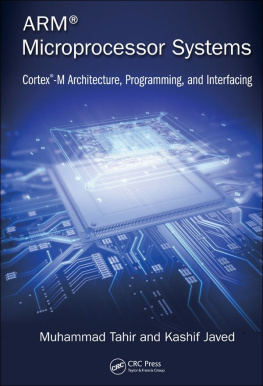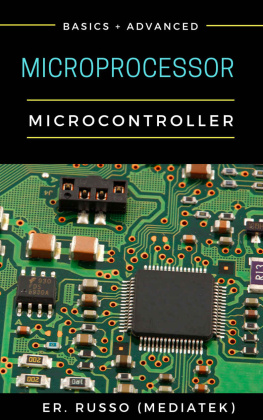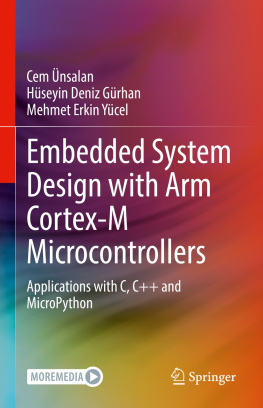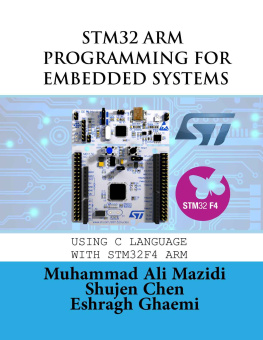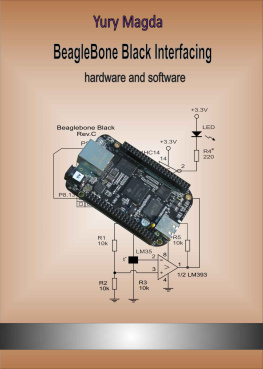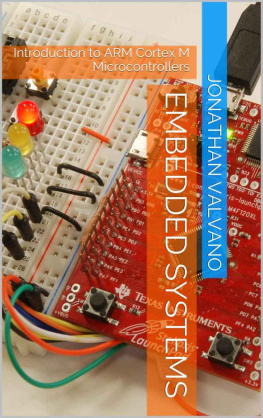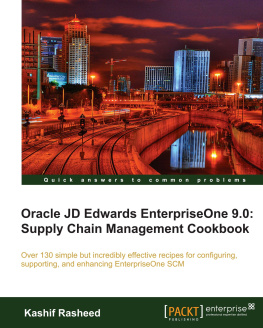Javed Kashif - ARM microprocessor systems : Cortex-M architecture, programming, and interfacing
Here you can read online Javed Kashif - ARM microprocessor systems : Cortex-M architecture, programming, and interfacing full text of the book (entire story) in english for free. Download pdf and epub, get meaning, cover and reviews about this ebook. City: London, New York, Boca Raton, year: 2017, publisher: CRC Press, Taylor & Francis Group, genre: Computer. Description of the work, (preface) as well as reviews are available. Best literature library LitArk.com created for fans of good reading and offers a wide selection of genres:
Romance novel
Science fiction
Adventure
Detective
Science
History
Home and family
Prose
Art
Politics
Computer
Non-fiction
Religion
Business
Children
Humor
Choose a favorite category and find really read worthwhile books. Enjoy immersion in the world of imagination, feel the emotions of the characters or learn something new for yourself, make an fascinating discovery.
- Book:ARM microprocessor systems : Cortex-M architecture, programming, and interfacing
- Author:
- Publisher:CRC Press, Taylor & Francis Group
- Genre:
- Year:2017
- City:London, New York, Boca Raton
- Rating:5 / 5
- Favourites:Add to favourites
- Your mark:
- 100
- 1
- 2
- 3
- 4
- 5
ARM microprocessor systems : Cortex-M architecture, programming, and interfacing: summary, description and annotation
We offer to read an annotation, description, summary or preface (depends on what the author of the book "ARM microprocessor systems : Cortex-M architecture, programming, and interfacing" wrote himself). If you haven't found the necessary information about the book — write in the comments, we will try to find it.
Javed Kashif: author's other books
Who wrote ARM microprocessor systems : Cortex-M architecture, programming, and interfacing? Find out the surname, the name of the author of the book and a list of all author's works by series.
ARM microprocessor systems : Cortex-M architecture, programming, and interfacing — read online for free the complete book (whole text) full work
Below is the text of the book, divided by pages. System saving the place of the last page read, allows you to conveniently read the book "ARM microprocessor systems : Cortex-M architecture, programming, and interfacing" online for free, without having to search again every time where you left off. Put a bookmark, and you can go to the page where you finished reading at any time.
Font size:
Interval:
Bookmark:
ARM
Microprocessor Systems
Cortex-M Architecture, Programming, and Interfacing
Microprocessor Systems
Cortex-M Architecture, Programming, and Interfacing
Muhammad Tahir and Kashif Javed

CRC Press
Taylor & Francis Group
6000 Broken Sound Parkway NW, Suite 300
Boca Raton, FL 33487-2742
2017 by Taylor & Francis Group, LLC
CRC Press is an imprint of Taylor & Francis Group, an Informa business
No claim to original U.S. Government works
Printed on acid-free paper
Version Date: 20170110
International Standard Book Number-13: 978-1-4822-5938-4 (Hardback)
This book contains information obtained from authentic and highly regarded sources. Reasonable efforts have been made to publish reliable data and information, but the author and publisher cannot assume responsibility for the validity of all materials or the consequences of their use. The authors and publishers have attempted to trace the copyright holders of all material reproduced in this publication and apologize to copyright holders if permission to publish in this form has not been obtained. If any copyright material has not been acknowledged please write and let us know so we may rectify in any future reprint.
Except as permitted under U.S. Copyright Law, no part of this book may be reprinted, reproduced, transmitted, or utilized in any form by any electronic, mechanical, or other means, now known or hereafter invented, including photocopying, microfilming, and recording, or in any information storage or retrieval system, without written permission from the publishers.
For permission to photocopy or use material electronically from this work, please access www.copyright.com (http://www.copyright.com/) or contact the Copyright Clearance Center, Inc. (CCC), 222 Rosewood Drive, Danvers, MA 01923, 978-750-8400. CCC is a not-for-profit organization that provides licenses and registration for a variety of users. For organizations that have been granted a photocopy license by the CCC, a separate system of payment has been arranged.
Trademark Notice: Product or corporate names may be trademarks or registered trademarks, and are used only for identification and explanation without intent to infringe.
Library of Congress Cataloging-in-Publication Data
Library of Congress Cataloging-in-Publication Data
Names: Tahir, Muhammad (Electrical engineer), author. | Javed, Kashif, author.
Title: ARM microprocessor systems : cortex-M architecture, programming, and
interfacing / Muhammad Tahir and Kashif Javed.
Description: Boca Raton : Taylor & Francis, CRC Press, 2017.
Identifiers: LCCN 2016038555| ISBN 9781482259384 (hb : alk. paper) | ISBN
9781482259391 (electronic)
Subjects: LCSH: ARM microprocessors-- Programming.
Classification: LCC QA76.6 .T337 2017 | DDC 005.1/8-- dc23
LC record available at https://lccn.loc.gov/2016038555
Visit the Taylor & Francis Web site at
http://www.taylorandfrancis.com
and the CRC Press Web site at
http://www.crcpress.com
Appendices
This book is the outgrowth of our experience in teaching the Microprocessor Systems course in the Electrical Engineering Department, University of Engineering and Technology, Lahore. The book contents are divided into three parts: architecture, programming, and interfacing. In architecture, we discuss the ARM processor and interrupt architecture. The programming part introduces the assembly language in a fair bit of detail. Once the reader is familiarized with the ARM processor architecture and its programming-using assembly language, then we describe interfacing various input/output devices with the microprocessor using different peripheral interfaces. Over the years, we have observed that teaching these three contents prepares the reader for attractive jobs in the embedded market. When an embedded engineer encounters an unknown architecture, his first job is to understand its architecture. The processor architecture knowledge equips the programmer to develop efficient programs. This is what we learned during our tenure as embedded engineers at Mentor Graphics (www.mentor.com).
Prior to 2013, we were teaching the course using the 80x86 microprocessor family. Because of the maturity of the 80x86 family, a number of good books was available. Architecture, programming, and interfacing can be covered from a single book. However, the interfacing aspect covered in most of the 80x86 texts is outdated. This can partly be attributed to the fact that the 80x86-based architecture has become too complex over the years and does not support many of the interfaces. For instance, the 80x86 used to have a parallel peripheral interface for printer interfacing that has become obsolete. It was not possible to conduct a good laboratory session based on the 80x86 architecture, which is highly important for such a practical subject. In the fall semester of 2013, we decided to switch to a different microprocessor architecture to improve the laboratory experience. After a thorough survey, we found ARM Cortex-M-based microprocessor to be the most suitable candidate. Afterward, the search for a suitable textbook began. We extensively searched but couldnt find a good textbook that incorporates architecture, programming, and interfacing aspects. So, we decided to write our own book. Our goal was to write a textbook that is easy to read and covers these three topics in fair detail. We have chosen ARM Cortex-M processor based microcontroller, TM4C123, from Texas Instruments for the hardware platform. The material is presented in a logical order along with interesting and practical examples to maintain the readers interest.
The book expects understanding of some basic concepts such as representation of numbers in binary and hexadecimal forms. We also assume that the reader is familiar with the basic digital systems. Knowledge of C programming language as a prerequisite is also a must to understand different example programs.
There are 12 chapters in the book. is dedicated to discussing the architectural aspects of exceptions and interrupts. We introduce the usage of Cortex-M nested vector interrupt controller (NVIC), different steps required to perform interrupt configuration, how to set up an interrupt vector table, and interrupt masking and handling. Toward the end of this chapter, advanced concepts such as interrupt tail chaining and interrupt nesting are presented.
describes program flow control instructions, including conditional and unconditional branch instructions, combined compare and branch, and IF-THEN (IT) block. The use of IT block allows conditional execution of many assembly instructions other than branch instructions.
The material covered in the first two parts doesnt require a specific hardware platform. Rather, one can use a simulator to learn the workings of different assembly programming instructions. However, of the book is related to analog interfacing. In this chapter, we present the basics related to analog-to-digital conversion (ADC) and then detail the various capabilities and configuration steps required to use the ADC module available on the TM4C123 microcontroller.
This textbook is aimed for the first course on microprocessor systems or embedded systems. The book is equally useful for electrical/computer engineering as well as computer science departments. The book assumes that the students should have experience with C programming language and digital logic design. The book is appropriate for undergraduate students. It can also be used to teach a first-year graduate course related to embedded systems. In addition to the theory related to ARM Cortex-M, the book has been written in such a manner so that one should be able to design ones own embedded systems after going through it. So, it should be useful to practitioners in the embedded industry working on ARM Cortex-M-based platforms.
Next pageFont size:
Interval:
Bookmark:
Similar books «ARM microprocessor systems : Cortex-M architecture, programming, and interfacing»
Look at similar books to ARM microprocessor systems : Cortex-M architecture, programming, and interfacing. We have selected literature similar in name and meaning in the hope of providing readers with more options to find new, interesting, not yet read works.
Discussion, reviews of the book ARM microprocessor systems : Cortex-M architecture, programming, and interfacing and just readers' own opinions. Leave your comments, write what you think about the work, its meaning or the main characters. Specify what exactly you liked and what you didn't like, and why you think so.

